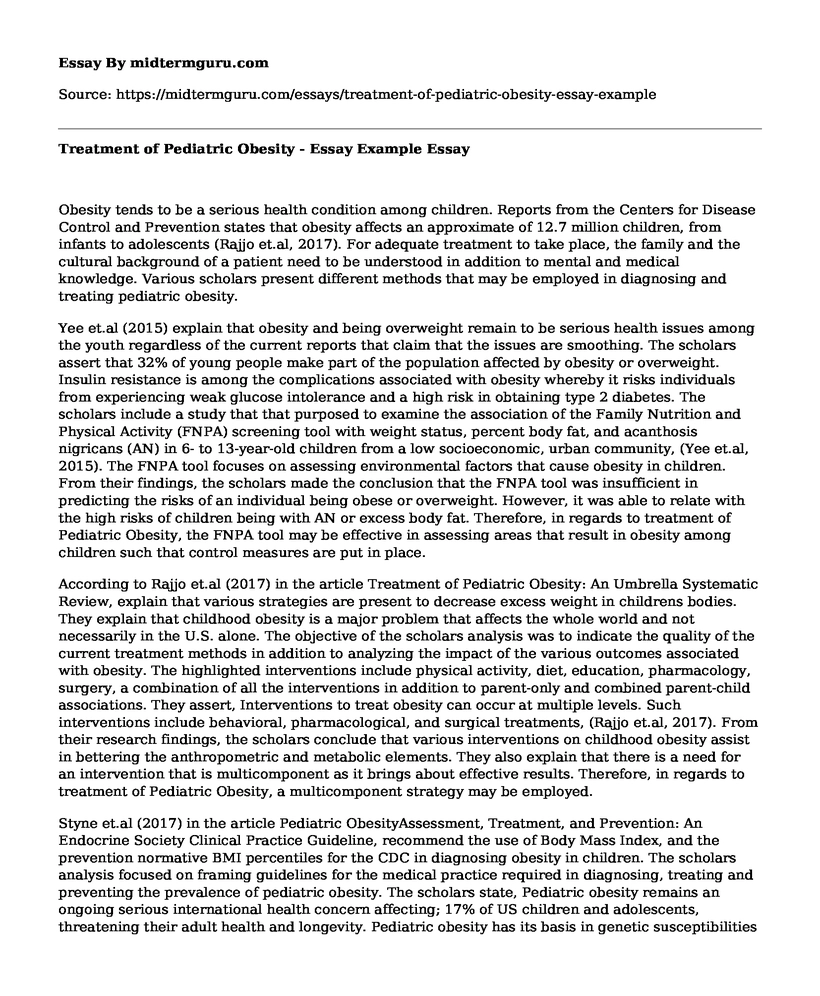Obesity tends to be a serious health condition among children. Reports from the Centers for Disease Control and Prevention states that obesity affects an approximate of 12.7 million children, from infants to adolescents (Rajjo et.al, 2017). For adequate treatment to take place, the family and the cultural background of a patient need to be understood in addition to mental and medical knowledge. Various scholars present different methods that may be employed in diagnosing and treating pediatric obesity.
Yee et.al (2015) explain that obesity and being overweight remain to be serious health issues among the youth regardless of the current reports that claim that the issues are smoothing. The scholars assert that 32% of young people make part of the population affected by obesity or overweight. Insulin resistance is among the complications associated with obesity whereby it risks individuals from experiencing weak glucose intolerance and a high risk in obtaining type 2 diabetes. The scholars include a study that that purposed to examine the association of the Family Nutrition and Physical Activity (FNPA) screening tool with weight status, percent body fat, and acanthosis nigricans (AN) in 6- to 13-year-old children from a low socioeconomic, urban community, (Yee et.al, 2015). The FNPA tool focuses on assessing environmental factors that cause obesity in children. From their findings, the scholars made the conclusion that the FNPA tool was insufficient in predicting the risks of an individual being obese or overweight. However, it was able to relate with the high risks of children being with AN or excess body fat. Therefore, in regards to treatment of Pediatric Obesity, the FNPA tool may be effective in assessing areas that result in obesity among children such that control measures are put in place.
According to Rajjo et.al (2017) in the article Treatment of Pediatric Obesity: An Umbrella Systematic Review, explain that various strategies are present to decrease excess weight in childrens bodies. They explain that childhood obesity is a major problem that affects the whole world and not necessarily in the U.S. alone. The objective of the scholars analysis was to indicate the quality of the current treatment methods in addition to analyzing the impact of the various outcomes associated with obesity. The highlighted interventions include physical activity, diet, education, pharmacology, surgery, a combination of all the interventions in addition to parent-only and combined parent-child associations. They assert, Interventions to treat obesity can occur at multiple levels. Such interventions include behavioral, pharmacological, and surgical treatments, (Rajjo et.al, 2017). From their research findings, the scholars conclude that various interventions on childhood obesity assist in bettering the anthropometric and metabolic elements. They also explain that there is a need for an intervention that is multicomponent as it brings about effective results. Therefore, in regards to treatment of Pediatric Obesity, a multicomponent strategy may be employed.
Styne et.al (2017) in the article Pediatric ObesityAssessment, Treatment, and Prevention: An Endocrine Society Clinical Practice Guideline, recommend the use of Body Mass Index, and the prevention normative BMI percentiles for the CDC in diagnosing obesity in children. The scholars analysis focused on framing guidelines for the medical practice required in diagnosing, treating and preventing the prevalence of pediatric obesity. The scholars state, Pediatric obesity remains an ongoing serious international health concern affecting; 17% of US children and adolescents, threatening their adult health and longevity. Pediatric obesity has its basis in genetic susceptibilities influenced by a permissive environment starting in utero and extending through childhood and adolescence (Styne et.al, 2017). From their perspective, finding ways to adopt systematic changes in environments with food and methods used in maintaining adequate changes in the body mass index are necessary.
As stated earlier, various scholars present different methods that may be employed in diagnosing and treating pediatric obesity. The common view presented by the scholars is that childhood obesity is a big problem and needs immediate control. The analysis presents the use of FNPA screening tool, a multicomponent strategy and the use of Body Mass Index, and the prevention normative BMI percentiles for the CDC in diagnosing obesity in children.
References
Rajjo, T., (2017). Treatment of Pediatric Obesity: An Umbrella Systematic Review. The Journal of Clinical Endocrinology & Metabolism, 102, 763775. http://dx.doi.org/10.1210/jc.2016-2574
Styne, D.M. et.al, (2017). Pediatric ObesityAssessment, Treatment, and Prevention: An Endocrine Society Clinical Practice Guideline. The Journal of Clinical Endocrinology & Metabolism, 102(3), 709-757. http://dx.doi.org/10.1210/jc.2016-2573
Yee, K.E., (2015). Association of the Family Nutrition and Physical Activity Screening Tool with Weight Status, Percent Body Fat, and Acanthosis Nigricans in Children from a Low Socioeconomic, Urban Community. Ethnicity and Disease, 25(4), 399-404.
Cite this page
Treatment of Pediatric Obesity - Essay Example. (2021, Jun 25). Retrieved from https://midtermguru.com/essays/treatment-of-pediatric-obesity-essay-example
If you are the original author of this essay and no longer wish to have it published on the midtermguru.com website, please click below to request its removal:
- Essay on Rethinking of the Euthanasia Controversy
- Paper Example on Role of Conflict and Ambiguity
- Nurses' Lived Experiences Caring for Pediatric Patients at End of Life - Research Paper
- Wellness: An Occupied Incorporation of Physical, Mental & Spiritual Welfare - Essay Sample
- 25 Years of Improving Community Health Through Collaboration - Essay Sample
- Bellevue Hospital: A Historical Journey of Care Since 1736 - Essay Sample
- Alternative Medicine: Exploring Options Beyond Standard Care - Essay Sample







